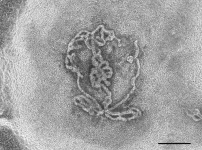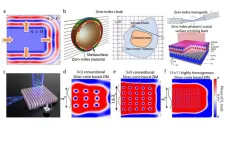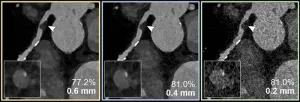(Press-News.org) An international genetic study using multiancestry biobanks has identified novel genetic locations associated with primary open-angle glaucoma (POAG), the most common type of glaucoma and the leading cause of irreversible blindness globally. The findings, published Feb. 20 in Cell Reports Medicine, detail ancestry- and sex-specific genetic loci associated with POAG and implicate vascular and cancer-related genes in POAG risk.
“Although there has been significant progress using genome-wide association studies (GWAS) to explore the genetic pathophysiology of glaucoma in humans, there is still a lack of understanding of the underlying pathogenic mechanisms and the genetic mechanisms that could explain the differences in prevalence, clinical presentation and outcomes for POAG across ethnicities and sex,” said Jibril Hirbo, PhD, research assistant professor of Medicine in the Division of Genetic Medicine at Vanderbilt University Medical Center and the corresponding author of the new study.
More than 3 million Americans have glaucoma, according to the Centers for Disease Control and Prevention. Members of some racial and ethnic groups are at higher risk of developing the eye disease: It is six times more common among Black Americans compared to white individuals. Other risk factors for glaucoma include high pressure inside the eye, being older than 60, having a family history of the disease, and having diabetes or high blood pressure.
In a collaboration involving institutions around the world, the researchers performed a meta-analysis of data from 15 biobanks that are part of the Global Biobank Meta-analysis Initiative (GBMI), a network of biobanks from four continents representing more than 2.2 million individuals of diverse ancestries. BioVU, Vanderbilt’s DNA biobank linked to de-identified electronic health records, is part of the GBMI network.
In the meta-analysis, they identified 62 genetic risk loci, six of which were novel. The researchers then merged their analysis with previously published multiancestry GWAS and used “sophisticated statistical methods to identify unique molecular actors across ancestries,” Hirbo said.
“The combined dataset represents the largest and most diverse POAG study to date with almost 1.5 million individuals and 46,235 POAG cases,” he added.
Overall, the study identified 17 novel genetic loci associated with POAG, five of which were specific to certain ancestries.
To identify functional roles of POAG-associated variants and tissues mediating genetic effects, the researchers used publicly available genotype-tissue expression data and performed gene enrichment studies. These, along with transcriptome-side association studies, implicated vascular and cancer genes in POAG risk, the researchers noted. In particular, 20% of the associated genes were related to primary cilia, a structure on the surface of many vertebrate cells involved in cell proliferation and signaling.
“Investigating mechanisms that influence primary cilia functionality will contribute to understanding the role of this structure in the pathogenesis of glaucoma and point to new therapeutic targets and strategies,” Hirbo said.
Although the analysis identified large ancestry- and sex-specific loci associated with POAG, Hirbo noted that the subjects represented by the GBMI biobanks are still predominantly of European ancestry. The investigators are seeking to broaden participants represented by international biobanks.
“Recruitment of cohorts that include ethnic minorities will improve knowledge transferability and health equity, not just for glaucoma research, but across disciplines,” Hirbo said.
Co-author and ophthalmologist Karen Joos, MD, PhD, marveled at how a simple conversation at an event in 2015 grew into a large international study of glaucoma.
“It has been rewarding being part of this endeavor ever since the initial exploratory brainstorming meeting at Vanderbilt and witnessing the project’s amazing growth with Jibril’s efforts into the global consortium of biobanks examining glaucoma,” said Joos, Joseph N. and Barbara H. Ellis Family Professor of Ophthalmology and chief of the Glaucoma Service at the Vanderbilt Eye Institute. “I expect it will continue to expand in discovery in the future as additional diverse biobanks are formed and join the consortium, and more samples are sequenced at all biobanks. A real global collaboration for one of the greatest worldwide blinding diseases is underway.”
Vanderbilt researchers joining Hirbo and Joos on the study included Nancy Cox, PhD, Eric Gamazon, PhD, Peter Straub, MS, Ran Tao, PhD, and Xue Zhong, PhD, from the Vanderbilt Genetics Institute and Milam Brantley Jr., MD, PhD, from the Vanderbilt Eye Insititute. The research was supported by grants from the National Institutes of Health (P50MD017347, U01HG011720, R35HG010718, R01HG011138, R01GM140287, R56AG068026), Joseph Ellis Family and William Black Research Funds, and Research to Prevent Blindness.
END
Large, diverse genetic study of glaucoma implicates vascular and cancer-related genes
2024-02-20
ELSE PRESS RELEASES FROM THIS DATE:
HPV vaccination among young adults before and during the pandemic
2024-02-20
About The Study: The results of this study suggest that human papillomavirus (HPV) vaccination coverage among young adults did not increase during the COVID-19 pandemic compared with prior years. This finding likely reflects pandemic-related disruptions in initiating the HPV vaccine among young adults.
Authors: Kalyani Sonawane, Ph.D., of the Medical University of South Carolina in Charleston, is the corresponding author.
To access the embargoed study: Visit our For The Media website at this link https://media.jamanetwork.com/
(doi:10.1001/jamanetworkopen.2023.56875)
Editor’s Note: Please see the article for ...
Historical redlining, persistent mortgage discrimination, and race in breast cancer outcomes
2024-02-20
About The Study: In a study of 1,764 women with breast cancer, living in a historically redlined area was associated with increased odds of a diagnosis of estrogen receptor–negative breast cancer in non-Hispanic Black women and increased odds of late-stage diagnosis in non-Hispanic white women. Persistent mortgage discrimination was associated with an increase in breast cancer mortality in non-Hispanic white women, and non-Hispanic Black women were more likely to die of breast cancer no matter where they lived.
Authors: Jasmine M. Miller-Kleinhenz, Ph.D., of Emory University in Atlanta, is the corresponding author.
To ...
Ancient genomes reveal Down Syndrome in past societies
2024-02-20
For many years, researchers at MPI-EVA have been collecting and analyzing ancient DNA from humans who lived during the past tens of thousands of years. Analyzing these data has allowed the researchers to trace the movement and mixing of people, and even to uncover ancient pathogens that affected their lives. However, a systematic study of uncommon genetic conditions had not been attempted. One of those uncommon conditions, known as Down Syndrome, affects nowadays around one in 1,000 births.
To their surprise, Adam “Ben” Rohrlach and colleagues identified six individuals ...
Can a single brain region encode familiarity and recollection?
2024-02-20
NEW YORK, NY — The human brain has the extraordinary ability to rapidly discern a stranger from someone familiar, even as it can simultaneously remember details about someone across decades of encounters. Now, in mouse studies, scientists at Columbia's Zuckerman Institute have revealed how the brain elegantly performs both tasks.
“These findings are the first evidence that a single population of neurons can use different codes to represent novel and familiar individuals,” said co-corresponding author Stefano Fusi, PhD, professor of neuroscience at Columbia’s Vagelos College of Physicians and ...
Pesticides found in kale but at low risk levels
2024-02-20
Kale fans can rest easy knowing pesticides used to grow the hearty greens are unlikely to end up in their salads or smoothies, a new chemical analysis of the superfood suggests.
Conducting novel tests that provide the most complete picture to date of a crop’s chemical makeup, the Johns Hopkins–led team found several pesticides and compounds in Maryland-farmed kale—but no cause for alarm.
“We do see minute traces of pesticides in the kale, but the levels we found are so much lower ...
Stress during pregnancy can lead to early maturation of first-born daughters
2024-02-20
Key takeaways
A UCLA-led research team found a correlation between certain aspects of early puberty in first-born daughters and high levels of prenatal stress in their mothers.
The researchers did not find the same result in boys or in daughters who were not first-born.
This early maturation may enable a first-born daughter to help her mother rear her other children successfully, according to UCLA anthropologist Molly Fox.
A UCLA-led team of researchers has found a correlation between early signs of adrenal puberty in first-born daughters ...
Bar-Ilan University researchers produce “laboratory testicles”
2024-02-20
The testis is responsible for sperm production and testosterone synthesis. Abnormalities in testis development and function lead to disorders of sex development (DSD) and male infertility. Currently, no in vitro system exists for modeling the testis.
Dr. Nitzan Gonen, a researcher specializing in the process of fetal sex determination, together with research students Aviya Stopel, Cheli Lev and Stav Dahari, has succeeded in creating "laboratory testicles" that may significantly advance understanding of the mechanisms involved in sex determination and provide solutions for male infertility, which affects one in 12 men worldwide.
The artificial testicles ...
Zero-index metamaterials and the future
2024-02-20
In the realm of materials science, electromagnetic (EM) metamaterials have emerged as a revolutionary class of engineered composites capable of manipulating electromagnetic waves in ways never before possible. Unlike their naturally occurring counterparts, EM metamaterials derive their extraordinary properties from their unique structural arrangements, allowing them to exhibit unattainable electromagnetic characteristics in conventional materials.
One of the most fascinating characteristics of EM metamaterials lies in the realm of zero-index metamaterials (ZIMs). ZIMs possess the ...
If your TV spoke to you, would you buy it? Study finds people spend more on some “talking products”
2024-02-20
BLOOMINGTON, Ind. – In the classic Disney film “Beauty and the Beast,” Lumière, the candelabra character, famously sings with Mrs. Potts, a tea pot, “Be our guest, be our guest. Put our service to the test. Tie your napkin round your neck, Cherie, and we provide the rest.”
When the 1991 Oscar-nominated song co-written by Indiana University alumnus Howard Ashman was released, it hardly seemed realistic that a product could sing its own praises and sell itself to consumers. But artificial intelligence today makes ...
Photon-counting CT improves coronary artery disease assessment
2024-02-20
OAK BROOK, Ill. – Ultrahigh-spatial-resolution photon-counting detector CT improved assessment of coronary artery disease (CAD), allowing for reclassification to a lower disease category in 54% of patients, according to a new study published today in Radiology, a journal of the Radiological Society of North America (RSNA). The technology has the potential to improve patient management and reduce unnecessary interventions.
Coronary CT angiography is a first-line test in the assessment of coronary artery disease. However, its diagnostic value is limited in patients with severe calcifications, or calcium ...






